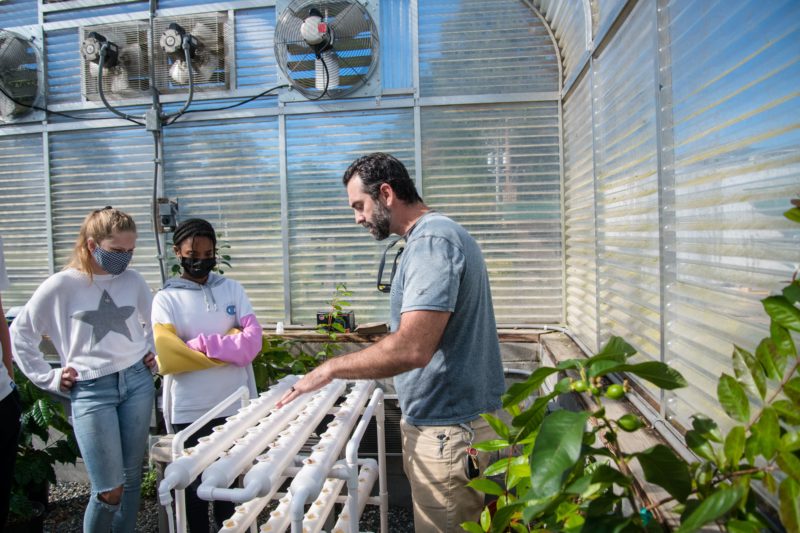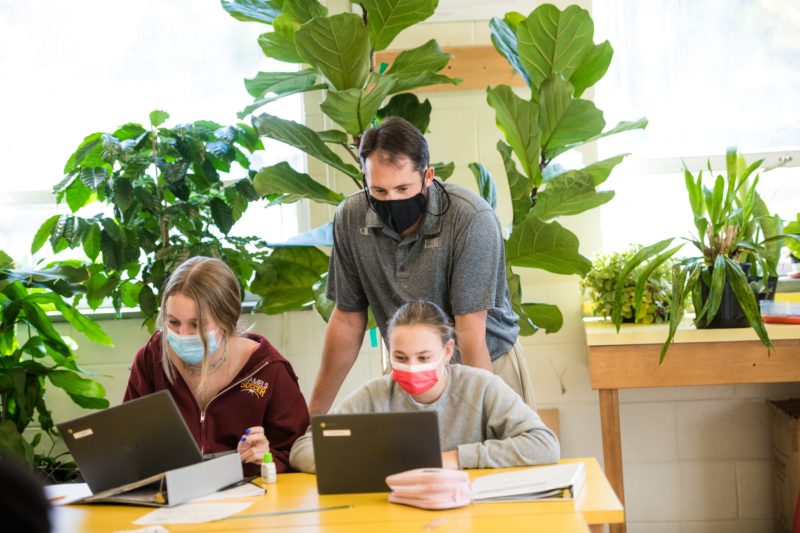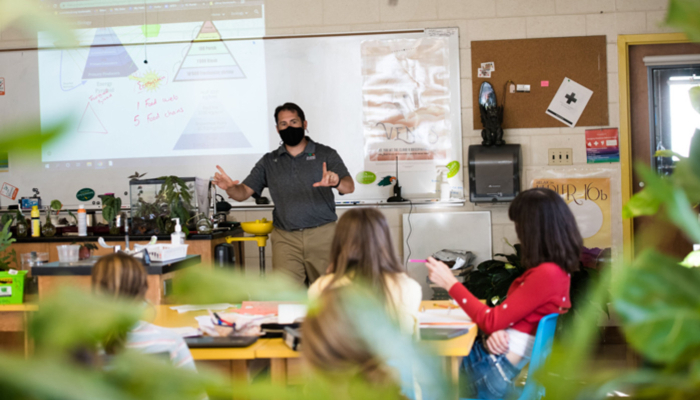By Guest Blogger Page Leggett
When Upper School science teachers TJ Petronzio and Jason Felten first came to Summit a decade ago, there was a small greenhouse on campus used mostly for storage. They knew it had a higher calling.
“The first year I was here, I started a hydroponic project where students grew eight heads of lettuce in four square feet of space inside that greenhouse,” Felten recalled. “It was a great project – and the lettuce was delicious.”
The two teachers applied for and won a grant to build a 20-by-25-foot greenhouse behind the science building.
“The goal,” Felten said, “is to continue this student-driven project and to let them try to grow more stuff hydroponically.” Felten, who teaches 9th grade biology, explained: “Hydroponics is basically growing plants without the use of soil or additives in the soil. With our lettuce, we have this spongy substance called rock wool that almost looks like cotton candy but it’s made out of rock; it’s very porous. We start seeds in there, and then basically run water through that material. The roots grow through the rock wool; there’s no soil – just a holding spot for roots. Water flows through a tiered system of PVC pipes with holes cut in them to water the lettuce,” he continued. “All that water goes down into a bucket, and a pump system pumps it back up
every so often. The roots are almost sitting in water; you add fertilizer to the water itself.”
Petronzio started using the greenhouse in his lessons right away. He asked students what they wanted to grow. “They almost always respond with fruits and vegetables they have been eating all summer – tomatoes, cucumbers, peppers. When I remind them those seeds need to be planted in the spring, without fail someone shouts ‘Pumpkins!’ “It’s why teaching them through planting is so important,” he continued. “Now that the greenhouse has been upfitted with hydroponic systems, we will grow all of our produce in the greenhouse. We will still start the seeds in my classroom, but instead of transferring them into the ground or into larger containers, they will be transferred to the hydroponic towers in the greenhouse where they should thrive all winter.
Students will be responsible for monitoring the pH of the water, adding the nutrient solution, and harvesting the greens. They will also need to figure out a rotation for when to plant new seedlings to keep the system continually producing.

“The students actually design the hydro systems,” Felten said. “They like the engineering side of things. So, besides the general science we teach, we also do a lot of engineering and design projects.”
A greenhouse makes a great learning lab. Why? “You have at least some control over the environment,” Felten said. “It makes it a lot easier to make predictions of what you think is going to happen. Students are here during the fall, winter, and spring. Cool season crops can be grown outside but you get all kinds of different weather patterns. In a greenhouse, you can see results a little faster.”
Chris Dalton, Summit’s new director of facilities, is involved in making the new greenhouse even better. “He has a huge amount of experience,” Felten said, “not only in hydroponics, but aquaponics, which is using fish for fertilizer in the water and growing plants in that. He’s helped us rethink the greenhouse.”
A greenhouse can be used for more than vegetables. Ninth graders are now growing 25 coffee plants in Summit’s greenhouse. The science department started a coffee project last year. They buy single-origin coffee beans, roast them on campus, and sell them to faculty and staff – and eventually to Summit families. Proceeds benefit the Monteverde Cloud Forest Preserve in Costa Rica, one of Summit’s service project partners. Ninth graders may eventually get to roast some of the coffee beans they grew.

Who knows? Students may yet decide to try their salad greens as they get older. Petronzio said, “Chef Justin Wilson is great about figuring out ways to incorporate what we grow into his menu. Hopefully, we can get to the point where we supply the greens for soups and salads. The goal will be for most of what we grow to be consumed by Summit students.”
Nothing tastes better than crops you raised yourself.
Come visit Summit’s campus and explore a match with your values and ours. More information may be found at www.summitschool.com or by calling us at 336-722-2777.
- Sponsored by Summit School, Photography credit: Sally Gupton
Want to get notifications on local events and happenings? Subscribe to Triad Moms on Main’s free weekly newsletters here.














